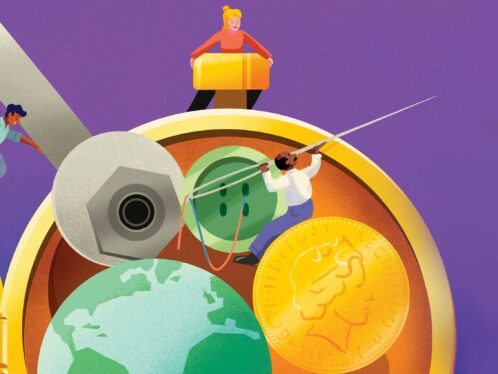A triple win
Universities and businesses are not the only beneficiaries of the increasing academia-industry collaboration. Students also benefit, finding themselves better prepared to compete in the real world.
When John Hepburn began his academic career as a chemistry professor and researcher at a top Canadian university in the early 1980s, most of his colleagues steered clear of collaborating on projects involving private companies. “Certainly in the physical sciences, there was a feeling that it was second-rate to deal with industry,” recalls Hepburn, who is internationally renowned for his work in laser spectroscopy, laser chemistry and quantum control of atoms and molecules. “The idea was that professors were there to teach and do basic research, not to help companies earn profits,” he says.
But times have changed. Formerly the dean of sciences, Hepburn is now vice-president, Research & International, at Vancouver’s University of British Columbia, Canada. He spends much of his time working on and/or promoting more than 900 research projects per year that the school and his academic colleagues there engage in with industry and government partners. “There are still some faculty members who think working with industry cheapens their role,” says Hepburn. “But they are a small minority, and their numbers are dwindling.”
And that trend isn’t confined to Canada. Around the world, universities and academics are shedding their ivory-towered images and collaborating with government and businesses in research projects and research centres devoted to everything from agriculture, biotechnology and chemistry to computer science, engineering and medicine. While that has raised some ethical concerns about the role of universities and the goals of academic research, there is much evidence to suggest that people everywhere are benefiting from the practical applications that have occurred as a result.
Nowhere is the merging of basic and applied research proving more helpful to humankind than in the field of health sciences. Universities and academics everywhere are now working closely with biopharmaceutical and biotech companies of all stripes and sizes to help discover, design and develop new and improved drugs, machines, techniques and therapies that can be used to treat what the World Health Organization calls “high burden” diseases such as cancer, infectious and cardiovascular diseases.
“In our ageing society, the number of patients with these chronic diseases is growing, and there is a need for more effective pharmacological treatments,” reads the website of the world-famous Leiden University, where Albert Einstein was working in the early 1920s when he learned that his theory of relatively had been confirmed. Already renowned for helping companies develop drugs such as the new peptide vaccine for human papillomavirus-induced cervical cancer, academics at the centuries-old Dutch school are now pooling their expertise with other private and public research groups in the new Leiden Center for Translational Drug Discovery & Development. “This alliance,” notes the school, “provides opportunities for innovative drug research that are unique in Europe.”
Similar scientific collaborations, partnerships, joint ventures and strategic alliances are springing up between universities, governments and businesses in all fields of scientific endeavour. Aimed at providing answers to vexing scientific mysteries – or to deal with serious manmade problems that may one day threaten human existence on Earth – those projects have spawned everything from energy-saving and greenhouse gas-cutting technologies to innovative electronic devices such as computers and DVD players.
Of course, collaborative efforts between university researchers and industrial scientists are nothing new. According to science historians, the two groups have worked together on various projects dating back to the Industrial Revolution. What is new, however, is the magnitude of these relationships and the impact that the resulting innovations can have on the schools, companies and even countries involved.
Most observers credit globalization – namely the worldwide shift in the 1980s and ’90s to knowledge-based economies that are fuelled by cutting-edge technology and put a premium on research – as the impetus for that change. At the same time, however, deep cuts in public funding to universities across much of Europe and North America forced academic researchers to look beyond campus walls for financing. For their part, cash-flush industries – particularly biotech firms faced with massive development costs trying to convert basic research into marketable items (industry’s “Valley of Death”) but hoping to develop the next big thing – were understandably eager to help.
As a result, industry-sponsored research in the form of grants, consulting contracts and collaborative training programmes has skyrocketed. According to Education Encyclopedia StateUniversity.com, an online resource for professional educators, industry provided 8 percent of total university research dollars in the United States in 2002, a se bild ure that has tripled since then. Similarly, more than half of all biotechnological firms in the US have collaborative agreements with universities, accounting for nearly a third of all funding in the field. A study in Japan found that the number of university-industry joint research projects there also jumped from some 3,000 in 1999 to more than 11,000 in 2005.
Though society and industry are reaping the benefits of those joint ventures, some fear they pose a threat to the integrity of pure academic research, which is supposed be devoid of commercial benefit. American business and ethics writer Norman Bowie, for example, warns that having corporate sponsors means university researchers are “caught between two compelling interests.”
While agreeing on the need to ensure academic independence, Hepburn says universities and academics have much to gain from their burgeoning relationships with industry. “Problems now are far more complex and complicated,” he says. “It makes sense to share knowledge and resources.” Participating in collaborative projects, he adds, also broadens his knowledge of public policy and industrial processes. “That helps me to be a better scientist.”
Hepburn adds that students also benefit from academia-industry collaboration. “I think academics have come to recognize that we are not training students to work at universities, but rather for life and work in the ‘real world’,” he says. “These projects permit my students to get a much better education by understanding the needs and ways of industry. Isolating them is counterproductive .”



